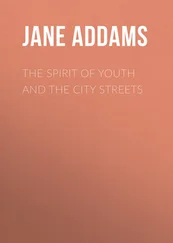Jane Addams - A New Conscience and an Ancient Evil
Здесь есть возможность читать онлайн «Jane Addams - A New Conscience and an Ancient Evil» — ознакомительный отрывок электронной книги совершенно бесплатно, а после прочтения отрывка купить полную версию. В некоторых случаях можно слушать аудио, скачать через торрент в формате fb2 и присутствует краткое содержание. Жанр: foreign_prose, История, foreign_edu, foreign_antique, на английском языке. Описание произведения, (предисловие) а так же отзывы посетителей доступны на портале библиотеки ЛибКат.
- Название:A New Conscience and an Ancient Evil
- Автор:
- Жанр:
- Год:неизвестен
- ISBN:нет данных
- Рейтинг книги:3 / 5. Голосов: 1
-
Избранное:Добавить в избранное
- Отзывы:
-
Ваша оценка:
- 60
- 1
- 2
- 3
- 4
- 5
A New Conscience and an Ancient Evil: краткое содержание, описание и аннотация
Предлагаем к чтению аннотацию, описание, краткое содержание или предисловие (зависит от того, что написал сам автор книги «A New Conscience and an Ancient Evil»). Если вы не нашли необходимую информацию о книге — напишите в комментариях, мы постараемся отыскать её.
A New Conscience and an Ancient Evil — читать онлайн ознакомительный отрывок
Ниже представлен текст книги, разбитый по страницам. Система сохранения места последней прочитанной страницы, позволяет с удобством читать онлайн бесплатно книгу «A New Conscience and an Ancient Evil», без необходимости каждый раз заново искать на чём Вы остановились. Поставьте закладку, и сможете в любой момент перейти на страницу, на которой закончили чтение.
Интервал:
Закладка:
Jane Addams
A New Conscience and an Ancient Evil
PREFACE
The following material, much of which has been published in McClure’s Magazine , was written, not from the point of view of the expert, but because of my own need for a counter-knowledge to a bewildering mass of information which came to me through the Juvenile Protective Association of Chicago. The reports which its twenty field officers daily brought to its main office adjoining Hull House became to me a revelation of the dangers implicit in city conditions and of the allurements which are designedly placed around many young girls in order to draw them into an evil life.
As head of the Publication Committee, I read the original documents in a series of special investigations made by the Association on dance halls, theatres, amusement parks, lake excursion boats, petty gambling, the home surroundings of one hundred Juvenile Court children and the records of four thousand parents who clearly contributed to the delinquency of their own families. The Association also collected the personal histories of two hundred department-store girls, of two hundred factory girls, of two hundred immigrant girls, of two hundred office girls, and of girls employed in one hundred hotels and restaurants.
While this experience was most distressing, I was, on the other hand, much impressed and at times fairly startled by the large and diversified number of people to whom the very existence of the white slave traffic had become unendurable and who promptly responded to any appeal made on behalf of its victims. City officials, policemen, judges, attorneys, employers, trades unionists, physicians, teachers, newly arrived immigrants, clergymen, railway officials, and newspaper men, as under a profound sense of compunction, were unsparing of time and effort when given an opportunity to assist an individual girl, to promote legislation designed for her protection, or to establish institutions for her rescue.
I therefore venture to hope that in serving my own need I may also serve the need of a rapidly growing public when I set down for rational consideration the temptations surrounding multitudes of young people and when I assemble, as best I may, the many indications of a new conscience, which in various directions is slowly gathering strength and which we may soberly hope will at last successfully array itself against this incredible social wrong, ancient though it may be.
Hull House, Chicago.CHAPTER I
AN ANALOGY
In every large city throughout the world thousands of women are so set aside as outcasts from decent society that it is considered an impropriety to speak the very word which designates them. Lecky calls this type of woman “the most mournful and the most awful figure in history”: he says that “she remains, while creeds and civilizations rise and fall, the eternal sacrifice of humanity, blasted for the sins of the people.” But evils so old that they are imbedded in man’s earliest history have been known to sway before an enlightened public opinion and in the end to give way to a growing conscience, which regards them first as a moral affront and at length as an utter impossibility. Thus the generation just before us, our own fathers, uprooted the enormous upas of slavery, “the tree that was literally as old as the race of man,” although slavery doubtless had its beginnings in the captives of man’s earliest warfare, even as this existing evil thus originated.
Those of us who think we discern the beginnings of a new conscience in regard to this twin of slavery, as old and outrageous as slavery itself and even more persistent, find a possible analogy between certain civic, philanthropic and educational efforts directed against the very existence of this social evil and similar organized efforts which preceded the overthrow of slavery in America. Thus, long before slavery was finally declared illegal, there were international regulations of its traffic, state and federal legislation concerning its extension, and many extra legal attempts to control its abuses; quite as we have the international regulations concerning the white slave traffic, the state and interstate legislation for its repression, and an extra legal power in connection with it so universally given to the municipal police that the possession of this power has become one of the great sources of corruption in every American city.
Before society was ready to proceed against the institution of slavery as such, groups of men and women by means of the underground railroad cherished and educated individual slaves; it is scarcely necessary to point out the similarity to the rescue homes and preventive associations which every great city contains.
It is always easy to overwork an analogy, and yet the economist who for years insisted that slave labor continually and arbitrarily limited the wages of free labor and was therefore a detriment to national wealth was a forerunner of the economist of to-day who points out the economic basis of the social evil, the connection between low wages and despair, between over-fatigue and the demand for reckless pleasure.
Before the American nation agreed to regard slavery as unjustifiable from the standpoint of public morality, an army of reformers, lecturers, and writers set forth its enormity in a never-ceasing flow of invective, of appeal, and of portrayal concerning the human cruelty to which the system lent itself. We can discern the scouts and outposts of a similar army advancing against this existing evil: the physicians and sanitarians who are committed to the task of ridding the race from contagious diseases, the teachers and lecturers who are appealing to the higher morality of thousands of young people; the growing literature, not only biological and didactic, but of a popular type more closely approaching “Uncle Tom’s Cabin.”
Throughout the agitation for the abolition of slavery in America, there were statesmen who gradually became convinced of the political and moral necessity of giving to the freedman the protection of the ballot. In this current agitation there are at least a few men and women who would extend a greater social and political freedom to all women if only because domestic control has proved so ineffectual.
We may certainly take courage from the fact that our contemporaries are fired by social compassions and enthusiasms, to which even our immediate predecessors were indifferent. Such compunctions have ever manifested themselves in varying degrees of ardor through different groups in the same community. Thus among those who are newly aroused to action in regard to the social evil are many who would endeavor to regulate it and believe they can minimize its dangers, still larger numbers who would eliminate all trafficking of unwilling victims in connection with it, and yet others who believe that as a quasi-legal institution it may be absolutely abolished. Perhaps the analogy to the abolition of slavery is most striking in that these groups, in their varying points of view, are like those earlier associations which differed widely in regard to chattel slavery. Only the so-called extremists, in the first instance, stood for abolition and they were continually told that what they proposed was clearly impossible. The legal and commercial obstacles, bulked large, were placed before them and it was confidently asserted that the blame for the historic existence of slavery lay deep within human nature itself. Yet gradually all of these associations reached the point of view of the abolitionist and before the war was over even the most lukewarm unionist saw no other solution of the nation’s difficulty. Some such gradual conversion to the point of view of abolition is the experience of every society or group of people who seriously face the difficulties and complications of the social evil.
Читать дальшеИнтервал:
Закладка:
Похожие книги на «A New Conscience and an Ancient Evil»
Представляем Вашему вниманию похожие книги на «A New Conscience and an Ancient Evil» списком для выбора. Мы отобрали схожую по названию и смыслу литературу в надежде предоставить читателям больше вариантов отыскать новые, интересные, ещё непрочитанные произведения.
Обсуждение, отзывы о книге «A New Conscience and an Ancient Evil» и просто собственные мнения читателей. Оставьте ваши комментарии, напишите, что Вы думаете о произведении, его смысле или главных героях. Укажите что конкретно понравилось, а что нет, и почему Вы так считаете.












